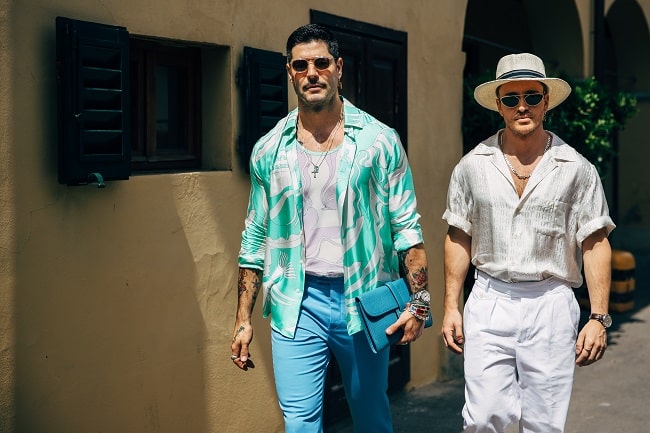1
HOME > Tips & Advice >
THE COOL FACTOR: UNDERSTANDING SUMMER FABRICS
ADAPTABLE SUMMER DRESSING FREQUENTLY COMES DOWN TO THE FABRICS YOU WEAR
Written by Ivan Yaskey in Tips & Advice on the 15th August 2019

Shorts and a tank? That’s the easy man’s way for staying cool. But, how many of us can do some Pitti Uomo dandy-esque sprezzatura? Just the thought of long trousers and a blazer is enough to feel the beads of sweat forming on the back of your neck. Don’t be intimidated, though. Adaptable summer dressing frequently comes down to the fabrics you wear. Here’s what you should know about finding and choosing warm-weather materials:
What to Look for in a Summer Fabric
Weight plays an important role, but truth be told, you’ll feel vastly cooler in lighter-weight cotton than you will in a comparably light synthetic material. Why’s that? Weave plays a factor, and the more open it is (you can see the gaps between the warp and weft), the greater the space air has to pass through. Conversely, a tighter weave essentially creates a nearly impenetrable wall against air circulation. Sweating, then, is imminent. Added to this, don’t forget about colours. Lighter shades – the spectrum of pastels, whites, and light greys – tend to reflect better. Darker hues – black and charcoal, plus burgundy, navy, and deep green – absorb it more. Sweat absorbency further plays a role – and natural fabrics always do it better. While certain synthetics like polyester repel moisture, the fabric itself won’t cool your core. And, realise that perspiration can only go so many places. Eventually, all that wicking, especially with cheaper garments, flows right back toward you. Cotton and linen, plus a few other natural fabrics, are known to soak it all in – not what you want out on a cool-weather hike, but perfect for an August afternoon in the city.

Cotton’s a Good Starting Place
When it doubt, choose cotton. Day or night, in all forms, it’s breathable, and when coupled with a lighter weight (30 to 150gsm, preferably), it’s less likely to lock moisture and heat in. Understand that, in this regard, not all cotton is equal. Come August, the last thing you want to be wearing is a corduroy shirt or a trucker jacket – unless you know you’ll be in an air-conditioned space all day. For summer, your choices often boil down to:
Chambray: For shirts especially, this fabric came back in full force a few years ago. While the weave is similar to denim (and the fabric’s also often indigo dyed), it features a looser plainweave and a lighter weight. Short of linen/cotton denim, it’s the best summer-friendly jeans alternative.
Seersucker: It’s not just for the Kentucky Derby and country clubs. Like chambray, seersucker’s been seeing a resurgence for the same reason – it’s pretty cool during the summer. Unlike chambray, seersucker uses a wavy, puckered texture, which in turn causes the fabric to sit away from the skin and the air to flow throw.
Gauze: Not just for curtains and hospital bandages, gauze resembles a cross between chiffon and linen – almost transparent but with a visible weave. This plainweave fabric succeeds in tropical weather for its almost-porous texture.

Madras: These days, 'madras' is nearly synonymous with a certain multicoloured check, but years ago, the fabric closely resembled gauze with its wide, open weave and ultra-light texture.
Poplin: We associate it with short-sleeve button-fronts, perhaps with a floral pattern, so it’s not too far-fetched to understand that poplin’s a quintessential everyday summer fabric. Mercerisation softens and lightens the material, offering the right mix of substance and breathability.
Panama/Oxford: Whatever you want to call it, this loosely woven, checkered basketweave material is all over spring- and summer-weight shirts and blazers.
Cotton, though, has its downsides. Aside from being basically disowned by the outdoor and active communities, it’s known to shrink – watch those dryer settings – and should it get damp and sit around, may attract mold and mildew.

Other Summer-Friendly Natural Fibers
Cotton’s not your only choice this time of year. We’ve covered linen’s merits before: Made of the flax plant, this twill or plain woven material is stronger than cotton, significantly more moisture absorbent, and naturally has a loose, open weave. In spite of these pluses, it’s known to wrinkle very easily – be careful especially with a full-on suit. Tropical wool has been revisited in recent years, likely riding on merino’s coattails. Like the quintessential sock fabric, tropical-weight wool naturally wicks away moisture to keep you cool, but has a much lighter weight: 200gsm, versus 300 to 400 gsm. It’s ideal for blazers, full suits, and even summer socks, as it exceeds cotton’s moisture absorbency while offering quick-dry properties. It drapes well, too, so it comes across as refined and professional.
Silk’s the O.G. of high-end summer fabrics, feeling featherweight to the point it seems barely there, letting your skin breathe, and just generally flowing along. Pair it with a Hawaiian print, and you’ve got old-school Miami style down pat. But, in spite of these vibes, don’t spend too much time in the sun. UV rays affect silk’s delicate quality, breaking it down and damaging it with time. As a more practical alternative to silk, rayon – and its close cousin viscose – overlaps with a similar feel. In fact, in the late 19th century, viscose was developed as an artificial, cost-effective version. These semi-synthetic materials – they’re manmade from cellulose – can get very thin, and with the right cut, simply let the breeze do its own thing. Yet, be forewarned about more close-fitting garments: Because rayon and viscose are still synthetics, they’ll cling like crazy to your skin and don’t offer the breathability of cotton.

What to Avoid
As a general rule, steer clear of heavyweight materials as much as you can. Aside from corduroy, traditional and Selvedge denim, plus cotton duck, are best reserved for mid-fall and after. Equally on par, steer clear of synthetics as much as you can. They might help control sweat or offer durability, but the fabrics themselves trap body heat, no matter how thin they are. Pay particular attention to:
Nylon: You’ll find it in plenty of travel and hiking garments. Once mixed with spandex, it delivers the perfect one-two punch of durability and flexibility, and when it is lightweight and loose fitting, it can feel rather comfortable. However, it’s not moisture absorbent: While you’re on that Italian sightseeing trip, don’t be surprised when sweat starts dripping down your calves.
Acrylic: Cheap sweaters, anyone? Beyond the lack of breathability, it often has a rather coarse texture, resulting in chafing and general discomfort once you feel the perspiration coming.
Polyester: Much like nylon, polyester has its pros and cons, but with the former being short in supply during summer. Yes, it resists wrinkles and moisture throughout the year, and it can be made fairly lightweight, but once the sun’s high in the sky, it’s the equivalent of exercising in a trash bag. Need we remind you of Bradley Cooper in Silver Linings Playbook?

What's your favourite summer fabric? #Style
— Menswear Style (@MenswearStyle) August 16, 2019

Trending
2
3
4
5
6
7
8
9
10










